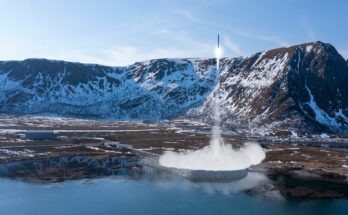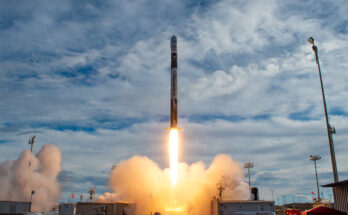by Bill Ostrove, Space Systems Analyst, Forecast International.
With much fanfare, SpaceX successfully conducted a test launch of its Falcon Heavy rocket. The rocket lifted off from Cape Canaveral at 3:45 p.m. EST (8:45 p.m. UTC) on February 6. Following launch, the Falcon Heavy successfully placed its payload, one of CEO Elon Musk’s Tesla Roadsters, into its intended orbit. Two of the three boosters also returned for a successful landing. The one small mark against the mission was the failure to land the core stage on SpaceX’s ocean barge.
The mission was not considered a guaranteed success before liftoff. In fact, Elon Musk himself had said the launch had only a 50-50 chance of success. A first launch of a new rocket is always high risk. The launch was made more difficult by the fact that SpaceX integrated three Falcon 9 cores, each with nine rocket motors. So if even one of the 27 engines had experienced a problem, the launch would have been a failure.
Considering those difficulties, a launch failure would not have been a significant loss for SpaceX, since the bar for success was so high. However, a success is great news for the company. SpaceX has dedicated almost seven years to development of the Falcon Heavy. Integrating the three cores turned out to be more difficult than the company had originally expected, so the successful launch was the culmination of a massive effort by SpaceX engineers.
SpaceX’s Falcon Heavy now joins other heavy-lift launch vehicles in the market, such as the Delta IV Heavy, Proton-M, Long March 5, and Ariane 5 ES. The Falcon Heavy can lift more payload than any of its competitors. At $90 million per launch, it’s also the cheapest heavy-lift option available. The Delta IV Heavy, for example, typically costs $350 million to $400 million per launch. A launch aboard others, such as the Proton and Long March 5, can be purchased for about the same price as the Falcon Heavy, but these rockets offer significantly less lift capacity.
SpaceX is able to offer the Falcon Heavy for such low prices partly because it is reusing the boosters, making the Falcon Heavy lift a major victory for proponents of reusable launch vehicles. The two side boosters used on the initial launch of the Falcon Heavy had been previously used on Falcon 9 core stages. One carried a communications satellite into orbit for Thaicom in 2016, while the other carried a Dragon capsule to the International Space Station for NASA in 2016. By using “flight proven” boosters, SpaceX is able to offer the Falcon Heavy for $90 million. That’s only 45 percent more expensive than a Falcon 9 launch, which consists of only one core booster, and about a quarter of the price of a launch using a Delta IV Heavy.
Despite the resounding success of the launch on February 6, the Falcon Heavy is a launch vehicle in search of a market. Since development began in 2011, SpaceX has improved the capabilities of its Falcon 9. Initial versions of the Falcon 9 could carry up to 10,450 kilograms to low-Earth orbit (LEO). The most recent version can carry up to 22,800 kilograms to orbit, making it one of the more powerful rockets on the market in its own right.
At the same time, small satellites have increased in popularity. In 2011, the average launch mass of all satellites placed in orbit was 2,986.4 kilograms. By 2017, the average had declined to 797.9 kilograms. With more small satellites being launched and fewer large satellites being launched, the market for a heavy lift launch vehicle is questionable.
For that reason, SpaceX now expects to conduct fewer Falcon Heavy launches per year than it did when introduced. In 2011, SpaceX expected to conduct 8 to 10 Falcon Heavy launches per year. Now, the company expects to conduct only two or three. In addition, Elon Musk no longer plans to carry human explorers on the Falcon Heavy. Instead, SpaceX will turn its focus toward the BFR, a larger rocket that will use a single core stage to travel into deep space.
Still, launches of the Falcon Heavy will continue. The biggest positive the rocket has on its side is that its large payload capacity and low price will create opportunities that don’t exist today. It will enable companies or space agencies to launch heavier payloads farther into space. That means that NASA may be able to launch exploration missions more frequently, or companies may be able to build a commercial space station either in low-Earth orbit, or farther away. In other words, the Falcon Heavy creates new opportunities to do business in and explore space.
Please feel free to use this content with Forecast International and analyst attributions, along with a link to the article. Contact Ray Peterson at +1 (203) 426-0800 or via email at ray.peterson@forecast1.com for additional analysis.
Download Forecast International’s 2017 launch vehicle review to get the latest information on launch trends from last year. The review will help place SpaceX’s latest achievement in context with analysis and data from the launch market.
A military history enthusiast, Richard began at Forecast International as editor of the World Weapons Weekly newsletter. As the Internet grew in importance as a research tool, he helped design the company's Forecast Intelligence Center and currently coordinates the EMarket Alert newsletters for clients. Richard also manages social media efforts, including two new blogs: Defense & Security Monitor, covering defense systems and international issues, and Flight Plan, which focuses on commercial aviation and space systems. For over 30 years, Richard has authored the Defense & Aerospace Companies, Volume I (North America) and Volume II (International) services. The two books provide detailed data on major aerospace and defense contractors. He also edits the International Contractors service, a database that tracks all the contractors involved in the programs covered in the FI library. More recently he was appointed Manager, Information Services Group (ISG), a new unit that encompasses developing outbound content for both Forecast International and Military Periscope.



